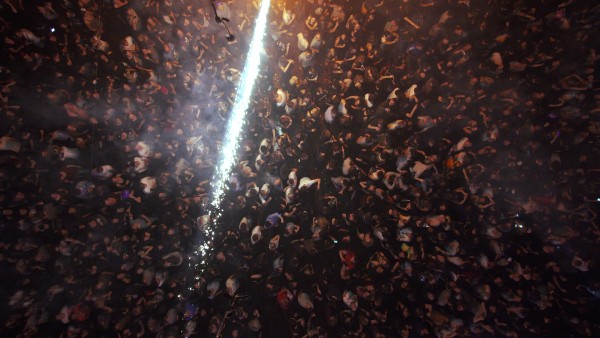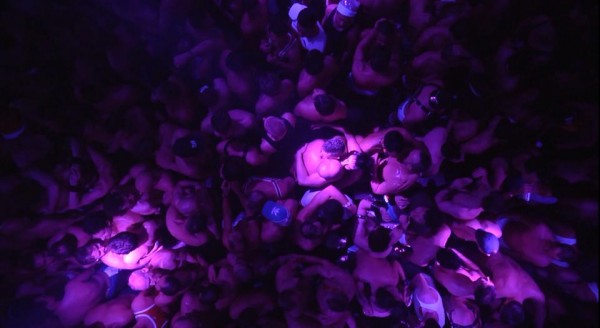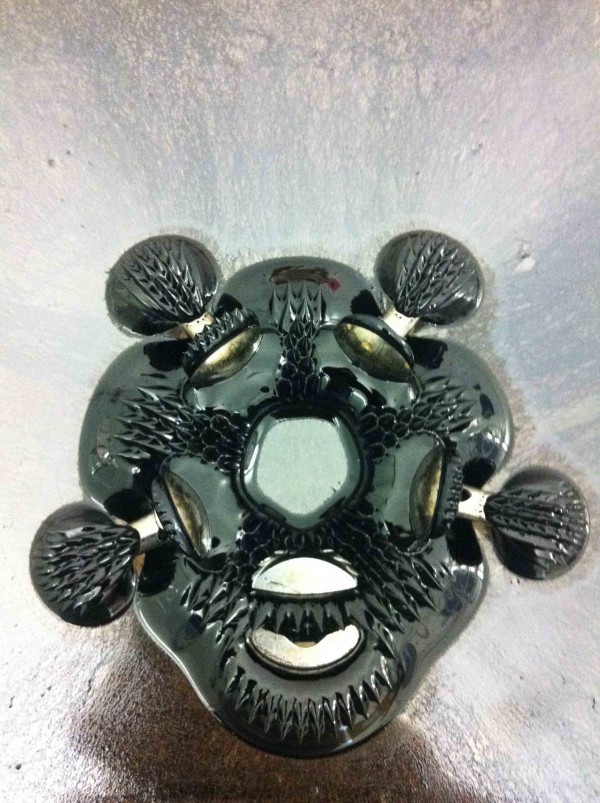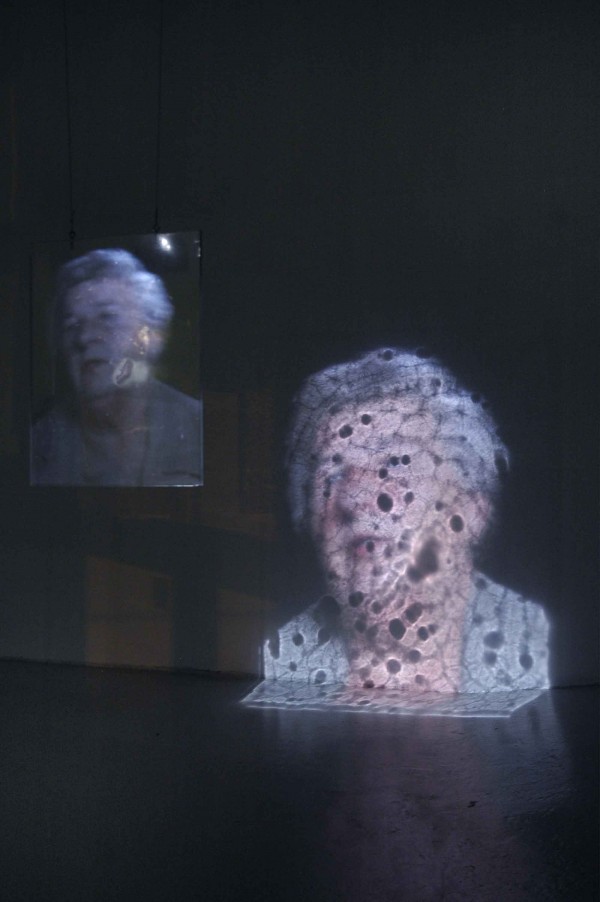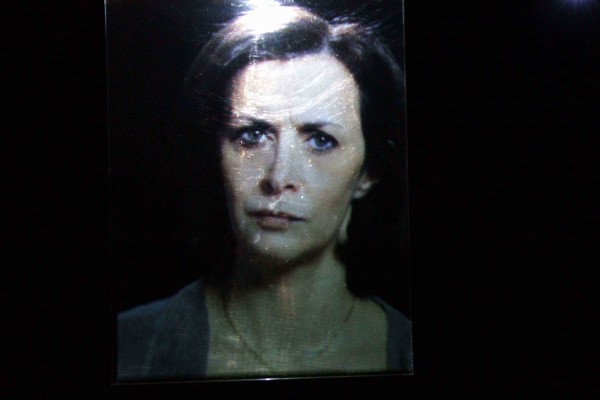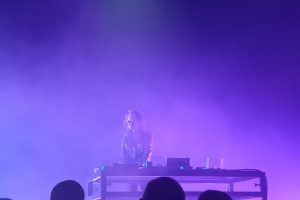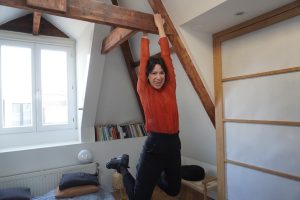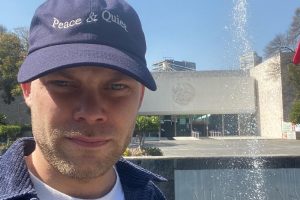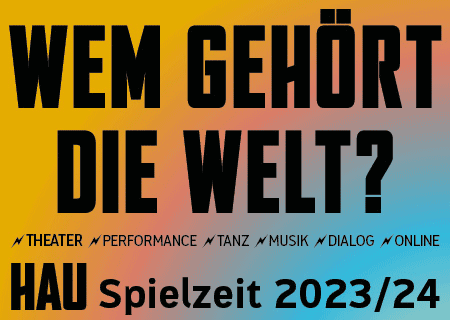“I am interested in catching the ghosts of the dance-floor.”
In April of this year I followed an invitation of We Are Europe, the network of eigth European festivals, to Belgrade for Resonate festival – and got deeply stuck in the super well curated conference. Located at the Kinothek of Belgrade, this mix of presentations, discussions and workshops is nothing less than a huge playground of ideas, visions and realised projects.
The Serbian artist Bogomir Doringer (based in Amsterdam) presented his ongoing project “I Dance Alone“, for which he is filming dance-floors from a bird’s eye view and observes the found collective and individual choreographies as mirrors of social, political, and environment changes. In his presentation he proclaimed that the cameras are not catching any faces and that his studies are not intended to de-invidualize the people on the observed dance-floors, it is more about a deeper understanding where, why and how we dance the way we dance.
Bogomir, I was quite impressed from your presentation here at Resonate. Please say some words to the genesis of “I Dance Alone“?
Bogomir Doringer: Growing up here in Belgrade meant to experience clubbing as a functional act against the political regime of Yugoslavia. It was a statement. If you were against the war – you went on raves. Clubbing had an urgency. The way the people were dancing was so different from what I experienced in Amsterdam after moving there a few years ago– a real cultural shock. I actually went into a party called „Sensation White“, one of those trashy parties where everyone is dressed in white – a friend was djing, I had a ticket and was clueless whats going on and was in general open for new experience. So I was standing there and looking from above on the ground and saw lots of circles. The people were gathering with their friends in circles. This was visually looking so different from the raves in Belgrade where everybody was just dancing towards the dj. Those two choreographys were so different. It was a cultural shock as it showed me quite abrupt that I will not be able to continue the same clubbing habits as in Belgrade. I had to realise once again: Serbia is a train on delay.
So I though for myself how amazing it would be to make images of those two crowds and reflect if these images tell us something about the society they are shot in. Are we able to mirror the sociopolitical environment in the dance-floor? I was visually triggered.
That was in 2004 – it took ten years until I started working on it. All those years I was wondering if I will ever have again those intense choreography experiences I had as a teenager. Then I started to feel that with the refugee crisis and the political changes happening the dance-floors are getting more wild and that people are trying to interact differently while dancing, spreading more in the space. From this observation on I started to record the partys to check my theses.
You mentioned that already back in the 90s in Belgrade the people were dancing towards the dj. A tendency which came up in my club environment only within the last decade – before that I was used to people getting totally lost in music and dance alone and with friends in all directions without this magnetic orientation field of the dj.
Well, you still find that on gay dance-floors. That said: Berghain obviously has a big impact on the ways clubs and partys are structured these days, even the dark rooms are more and more included as necessity and new norm. In Amsterdam we have for example a club called De School bringing in this vibe, a kind of a franchise version of Berghain, like McDonalds of clubbing culture..
That´s funny you already see De School in a category like that as the club has a very good booking and reputation and is loved by everyone you speak to.
Oh, don´t get me wrong. I totally enjoy De School and love to see how this young scene of producers and club people are gatering there. In opposite to Berghain that acts educational and authoritative, with some kind of fear and respect demand, De School is more kind and teaching the young scene in more subtile way – I do prefer that more. As somebody who did studies in the Netherlands this is very Dutch and it works,
But if you think in terms of how spaces are organized, the way the speakers are fixed, the dark rooms – these are parts influenced by the club Berghain. If Berghain would not have made certain steps, we would not find a club like De School. The night life of Amsterdam and many other cities went down the hole at 15-10 years ago. Berghain set up new requirements.
The dancefloor at Berghain is dynamic and wild, so the people get infected and bringt this tendency with them home to their city and club – it is like a virus. It is always interesting, when I travel, to detect those who visited Bargain and see how choreography of that club became World dance.
What derivations do you take from your photos and films?
I am right now in process of applying for some funding to work for a period of two years on art science research. Therefor the plan is to work with a team of scientists and academics including bio-chemists for example – the idea is to find out if we could understand whats happening on the dance-floor by bringing together natural science and choreography reflections?
By writing the funding application it became clear to me that we are writing a dance-notation. But it is not just about the dance-notion for a group of people, by zooming in were are also able to come up with insights about the individual dance-notation.
Besides the statstic research I am fascinated about the visual aspects of our project. It is strucking to look on those films of the dance-floor and see certain patterns, categories of dancers and dance-floors.
How easy / difficult is it to get the permission to film in the clubs?
It depends on the club. Of course there are ethical aspects, but in the end it is a question of the right communication to explain our ideas – we do not film the faces for sure. Like everywhere you have to find the right person to talk to, an open-minded person. In Amsterdam it helped a lot that we now have a Night Mayor Mirik Milan. It also helps a lot to have more and more material to show to the clubs from earlier filming to understand the direction of „I Dance Alone“.
How do you chose the clubs for „I Dance Alone“? Is the goal to cover as many different ones as possible? Which compare dimensions are you interested in?
I started of with mostly the Clubs easy to get in contact with. But the more I travel the more new manifestations of club culture I get to know. For example there are clubs in Brasil where you have to give a sample of your finger print to get in – a club quite different from a club like Drugstore here in Belgrad. It is for sure in our interest to find out about the differences between commercial and underground clubs and their dance-floors.
In some of the recordings I showed yesterday you saw quiet intense spinning and pushing moments – that was for example recorded at a spitality party at the Amsterdam Dance Event in Paradiso 2016. This party is for teenagers, the only party teenagers allowed to go to during Amsterdam Dance Event. In one moment there is this bold guy entering the dance-floor – you immediatelly what he is doing there as his dynamics are so different – and created the whole pushing experience. One guy started the whole thing. And these kids experiences it for the first time and tried to survive this change of their dance-floor and therefor cultivated unspoken within a second a circle. They connected and survived this aggressive situation.
Actually a lot of people are interested in „I Dance Alone“ coming from the topic of security and wonder if there is a way to predicate the dynamics. Obviously we live in an age of fear and the need for security – but I ain´t aim for that.
But what about socio-political conclusions?
I am not really interested in that part. There is something fascinating about watching people dance. And I find it interesting to watch a crowd from a perspective you are not used to – my thing are the choreographies, even if they are only subtle: just moving the head or the finger. This is almost an act of art. Amsterdam has Amsterdam patterns and Berlin has Berlin patterns.
Do you try to get informations regards the composition of the dance-floors?
We debated that. Should we try to find out the typical categories like gender, age and race – but in order to do this we have to get on the ground with a questionary, or check the statstics of the ticketing or the cloths the people are wearing… But: I am interested in catching the ghosts of the dance-floor. What is the force that makes you feel united? What is this certain moment at a party when everyone feels that this is now a really good party? Is this visible? I try to catch that somehow with the camera.
In a way clubbing is such a primitive way of having fun. You place your body and mind in a certain state by the use of drugs and alcohol. You expose and open yourself to be driven by audio visual experiences. And then you communicate suddenly only with your body. What makes you dance in one moment and not the other?
Good point. It takes a lot to let the people feel free. And then also: often you do not dance the way you wanna dance cause it is too packed or there are some people you do not wanna run in. How do you identify influences like these?
Well, it is a process. Even if there is no space and you feel limited you will start to dance and somehow find the space. So observe how you do so? It´s also a question of how dedicated you are to dance. Will you take the efforts to get the space? It looks a bit like Ninjas in a fight. If you want to get between certain people you better have good moves, otherwise they beat you up. You are labeling the space, you are marking it – that´s what I also mean with primitive. On some partys is is okay to label the space like that, on others it is akward.
Bogomir, how old have you been when the war was happening – and what impact did that have on the nightlife here in Belgrade?
The war started when I was 6 and it somehow lasted till I was 18 when Milosevic was arrested Serbia and Belgrade were not in a same position as Bosnia was. This is where horror was. Nobody came to my door to kill me and my family cause of the religion. We inaway, even that war was going on still were protected in Belgrade. What was the most intense period I would say was NATO bombing of Belgrade in 1999. This is when danger was above my head. At that time I was confused about the politics. Stupid me thought we deserved to be bombed because of Milosevic’s politics. When the sirens would start we would gather in the techno club called Industrija. People were transforming their fear on the dance-floor and danced like it was their last day. They celebrated being alive and at the same time dealt with being stressed. When I was recently dancing, I realized how much fear is a hidden influence on me on the dance-floor. In 1999 we were definitve thinking: „Yeah, we could die any moment – but if so we better do it dancing.“Each of us particular remember these few months of boming as something super terrific and scary and also amazing. Fear and excitement. Tine line between pleasure and death, Eros and Thanatos.
Did it also feel back then like excitement?
Oh yes, it did. It was such an absurd situation. There were planes dropping bombs penetrating so deep into the ground that even in a shelter you would´nt survive. One human against those machines over your head. You were almost showing them the finger by dancing. We had no influence on the situation at all. We couldn´t do anything. I would not know what to also do at that age. This was the reality I grew up with.
Are you going on the dance-floors while filming for „I Dance Alone“?
No, I don´t dare. But I will do it soon.
I ask cause it might be of interest to see yourself dance from outside and reflect that.
I hear you. I am actually interested in that. I want to do it – but once you have the equipment installed and you start to scan the audience, it is so difficult to enter that energy. I tried once, but I felt spat out.
Last year I was attenting a really good party. I felt so free on that dance-floor. A few weeks later one of the organisers send me this link of a video someone filmed and to my surprise I was dancing intense but not nearly as free and room taking as I remember it.
The inner experience did not match the outside experience. This is such a typical thing for electronic music – and that´s where the title to the project comes from: „I Dance Alone“.
On each party these are the big questions: Am I dancing alone? Or are we in this together? It depends on the music and the drugs and so many other things.
Maybe it is better to not see yourself dancing besides the academic reflection of it. I am not a big fan of all those transmissions from the dance-floor.
Like Boiler Room – so embarrassing. We had an early boiler room in Serbia called “Pink Diskoteka”. If you appear there nobody would hang with you.
Well, I would be interested to see the difference in the dance moves when the camera is on red light and when not. I am pretty sure the people switch on performing modus once the light went red.
To me it feels like destroying those rare moments where the people have the chance to be totally free – but now again they are pressed in a system of function.
The role of cameras changed a lot in the last years. There is a lot of footage from the 70s and 80s when the camera was even rolling with strong light but the people were still so innocent that they did not really know what the camera is doing, they did not have those patterns of reaction yet, they were still free. Today most people feel embarrased with the lightening conditions.
But not only the role of the camera changed. Nowerdays we live in times of perfect bodies. Everybody goes to the gym, even when we get wasted we get good stuff. But still people are not showing this with extrovert gestures – you rarely see hands in the air.
The reason for doing this project is also that I want to understand why people stopped dancing that way. I mean there are of course clubs where people do dance wild – but it is not the rule these days. Then again you find special places where the dancing included a feeling of urgency. Like in Georgia in the club Bassiani right now for example. We should never forget that in a lot of countries and cities it is not the norm to go dancing – we take this for granted as we could go out all the time. Amsterdam is a city that encourages clubbing a lot: we have festivals almost every weekend and they are sold out months upfront even with not cheap tickets at all; here are always new drugs coming in town….
But in a lot of places you have to fight to dance. Take Russia where they forbid it in a macho bongo show off that they are in charge.
Las December Flash Art published an issue dedicated to clubbing. One article was saying that Paris got much better in regards to clubbing since the terrorist attacks. Because a group of teenagers used to be in Berlin and got influences and started to organise illegal raves. In one of the interviews it was mentioned that the fear and the struggle on the ground of the streets of Paris resulted in the people wanted to dance more.
Bogomir, do you see a connection line between „I Dance Alone“ and your other projects?
I see more clearly now a connection between everything I did. Before I started to study Sociology I worked in fashion – an industry where you put criticism on the bodies of people and then those bodies go into public space and travel. I cant´t deny that „I Dance Alone“ is a surveillance project: we have cameras, we film and we analyze the data. A lot of people think that „Faceless“ was a project about privacy, but it was also a project avout surveillance. I was interested how the media generated images of terrorists and how a burka through media turns into an object of art and fetish and by that taking out of context. It was a lot about media generated images. While my previoius works were lot about media publications and how things that sound like fiction become real. It is always about crowd, it is always something collective. „Faceless“ was about a crowd, the compartment of 100 artists and fashion designers. I am interested in social phenomenas that manifest themselves on bodies and in bodies of the people. There is book now coming out on this topic.
With „Hospitality“ you analyzed how soliders deal with the ghosts of war when finaly being home again – and also illness.
The project is connected to bombing again. The bombs used during the Nato bombings contained depleted uranium. The weapons which are called DU were very effective because it melts the objects. When it penetrates a tank or building it first melts it and creates an entrance and explodes inside – and makes sure the target is destroyed. This successful weapon was created in the 1970s and used during the first Gulf War already. My mother was a medical worker and she was alarming we should wear masks and don´t breath in as the polution was very dangerous. I did not really care. But after moving to Amsterdam in 2007, I read more and more that young people and people in general were dieing cause of cancer. So I started to research it journalistically. There was this dutch solider who had 76 different forms of blood cancer and he claimed this was coming from the pure uranium in the bombs. That particular moment I decided to jump on the project and look into how much of my life was sharped by media. Let me find that people and talk to them. It started as a journalistic project – but I got into collecting their uniforms and searched footsteps of polutions on them. The uniforms were normally either returned to the state aftr the war or being burned, but still a lot of people kept them as an artefact.
These people were permanent on the ground here and then they went home – I wanted to give them a voice.
Looking at my works I went for a big transistion from being concerned about the role of the media and their fabrications to get into the body and on the body of the people and work with body-samples or biological material and extract with modern equipment data and make it visuable. Our bodies are data in a way, a cultural heritage.
The following two questions were added later on by email.
Bogomir, since our interview in Belgrade a lot of positive things happened for you: you got accepted as a PhD for Artistic Research at the University of Applied Arts in Vienna, you won the 3Package Deal Award and you found a producer for your film to „I Dance Alone“.
What does that mean concrete regards the next steps of your projects?
It is good to not be alone sometimes. It feels comforting and empowering to get all this support. It means a lot to me. After all years of work and braveness. It also allows me to focus on one project instead of doing many more things in order to survive.
This means that for a while, it will all be about “I Dance Alone”. This is something that I always wished in the past.This kind of focus and devotion to one idea, vision. To have space and time to just do what I want.
You will give a speech at this years Amsterdam Dance Event. About what exactly?
I have been invited by the Why Not Festival to join their event in Paradiso on 21st of October during Amsterdam Dance Event. Topic of the festival is The Body and Beats. I will speak about the project in the context of the topic. This is also great oportunity to speak more in front of the music industry and clubbing audience.








